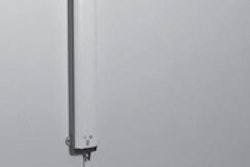LAS VEGAS - The rate of accidents in MRI suites has nearly tripled compared to just four years ago, highlighting the need for renewed attention to magnet safety as a means of protecting patients and avoiding legal liability, according to a presentation at this week's American Healthcare Radiology Administrators (AHRA) meeting.
Accidents in the MR suite have increased markedly over the past number of years, due primarily to innovations in the technology and its use for new applications such as trauma and in emergency rooms and intensive care units. The costs of handling the accidents and dealing with the interruption can cripple an imaging department, wreaking havoc on its fiscal viability and, in the case of lawsuits, its staff members' lives, according to Tobias Gilk, president and MR safety director at Mednovus of Leucadia, CA.
"Things have changed pretty dramatically," Gilk said. "For example, 3 tesla is the fastest-growing magnet in terms of growth in sales. And not only has the equipment we're using changed, the patients we're using it for have changed as well. And that means that the chances of something going squirrelly have increased."
Gilk made the case that administrators have to be vigilant about MR safety in a presentation at the AHRA annual meeting this week in Las Vegas.
The U.S. Food and Drug Administration (FDA) MedWatch adverse event reporting program estimates that since 2004, the number of MR accidents has increased 277%, and a patient's risk of suffering an adverse event in an MRI suite today has nearly quadrupled since 2004. Of course, those accidents can be anything from a patient developing a rash to a gurney ramming into the magnet. But despite the variability of definitions for "accident," the FDA's reporting has remained consistent and shows a dramatic spike, Gilk said.
"We're hurting people four times more than we were four years ago," he said. "If we were seeing a fourfold increase in highway fatalities, we'd all be driving 30 miles per hour." But this increase in the number of patients getting injured is still largely unaddressed.
The dramatic increase can't be explained by the theory that four times as many MR scanners are in use now, Gilk said.
"The growth in terms of imaging volume is 3% per year during that same time frame [2004 to 2008]," he said. "So we can explain 12% of that 277% in terms of growth in imaging volume, but 265% remains."
Part of what makes the problem so thorny is that although various bodies offer guidance for best practices in the MR suite, not one of them accredits facilities for MR safety, Gilk said. And until there are regulatory and accreditation standards for MR safety, civil litigation will be the only tool for enforcing that safety.
"Civil litigation as a means of patient and staff safety is like using a flamethrower to handle a cockroach problem in your kitchen," he said. "It's a very crude tool."
The three-part hydra of MR safety
The focus on MR safety really started in July 2001, when 6-year-old Michael Colombini died in a tragic MRI accident that has become the single greatest reference point for MRI safety, according to Gilk. And there are three parts to ensuring MR safety: clinical safety, operational safety, and site safety.
Clinical safety gets the most attention and includes issues such as device and implant safety, specific absorption rate (SAR) and radiofrequency heating, contraindications, and contrast agents. Vigilance around clinical safety issues can improve patient outcomes dramatically. For example, changes in how healthcare professionals perform MRI scans have all but eliminated cases of nephrogenic systemic fibrosis, a debilitating skin and joint disease related to MRI contrast, Gilk said.
Operational safety includes issues such as who has access to the MR suite, how patients are screened, what training incidental staff members receive, and how a facility responds to an MRI code.
"Run an unannounced code simulation and see what happens," Gilk suggested.
Finally, site safety covers issues such as a 5-gauss exclusion zone for the magnet, missile effect prevention, and cryogen safety.
Betting on best practice
Gilk directed AHRA attendees to various resources for best practice guidelines for the MRI suite, including the U.S. Department of Veterans Affairs' MRI Design Guide, the American Society for Healthcare Engineering's MRI safety monograph, and the Joint Commission's Sentinel Event Alert, Issue 38, which outlines a checklist of 10 issues to address for a safe MR suite:
- Access controls
- Screening of patients and devices
- Medical history for contraindications
- Trained MR professionals
- Annual training for ancillary staff
- Burn prevention
- FDA labels for all devices in the MR suite
- Plan for patients requiring clinical support
- Hearing protection
- MRI code procedures
Lessons on liability
What's the point of all these safety precautions? Certainly patient health, but the fact is, when there are accidents in the MR suite, the people most likely to end up as defendants in lawsuits are technologists and administrators -- the easiest targets -- rather than radiologists, manufacturers, or hospital CEOs. So following best practice protocols can protect patients and also the facility's staff.
Of course, an imaging department's staff has the best of intentions, and that staff is made up of qualified medical personnel. But these factors don't protect against MR accidents, Gilk said.
"MRI safety isn't an optional thing," Gilk said. "It's enlightened self-interest. If we reduce the incidence of these accidents, we protect our patients, our staff, and ourselves from litigation."
By Kate Madden Yee
AuntMinnie.com staff writer
August 11, 2009
Related Reading
Survey: MRI centers lack infection control, May 28, 2009
FDA warns of sandbags in MRI suites, April 3, 2009
U.S. FDA warns against wearing skin patch during MRI, March 6, 2009
Joint Commission may survey for MRI safety, March 5, 2009
11 steps for preventing MRSA infections in MRI, November 6, 2008
Copyright © 2009 AuntMinnie.com



.fFmgij6Hin.png?auto=compress%2Cformat&fit=crop&h=100&q=70&w=100)





.fFmgij6Hin.png?auto=compress%2Cformat&fit=crop&h=167&q=70&w=250)











